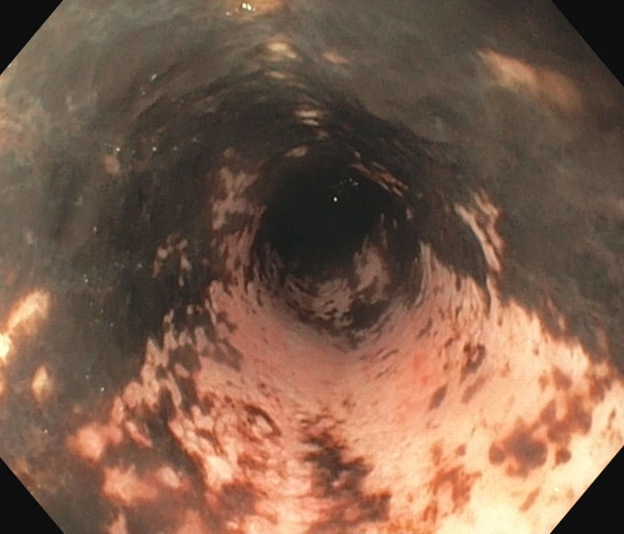Tuesday Poster Session
Category: Esophagus
P4946 - Black Esophagus in Patients With Diabetic Ketoacidosis: Risk Factors, Diagnostic Challenges, and Outcomes of Acute Esophageal Necrosis
Tuesday, October 28, 2025
10:30 AM - 4:00 PM PDT
Location: Exhibit Hall

Omar Zuhdi, MD
Lakeland Regional Health Medical Center
Lakeland, FL
Presenting Author(s)
Omar Zuhdi, MD, Amanda Rigdon, MD, Khoa Tran, DO, Robert Mendez, MD
Lakeland Regional Health Medical Center, Lakeland, FL
Introduction: Acute esophageal necrosis, also known as black esophagus and necrotizing esophagitis, is a rare condition involving a diffuse circumferential black appearance of the esophageal mucosa that affects the distal esophagus stopping at the gastroesophageal junction. The etiology is not completely understood; however, initial causes may include ischemia and gastric outlet obstruction. Acute esophageal necrosis has also been associated with broad spectrum antibiotic use, infection, gastric volvulus, diabetic ketoacidosis (DKA), and cancer. Patients may present with hematemesis, melena, dysphagia, chest pain, and sepsis.
Methods: A systematic literature search was conducted using PubMed, Scopus, and ScienceDirect to retrieve studies from inception up to April 2025. Studies describing acute esophageal necrosis in patients with DKA were extracted. According to PRISMA guidelines, two reviewers completed the initial title and abstract screening, full-text review, and data extractions. A total of 81 papers were included in the study.
Results: Among included studies, the majority of patients were middle-aged to elderly males with an average age of 56 and a range of 23-87. The most common comorbidities noted included coronary artery disease, renal failure, alcohol or substance use, malnutrition, and psychiatric illness. The majority of cases involved severe DKA with blood glucose above 800 mg/dL, acidosis with pH < 7.2, low bicarbonate < 10 mmol/L, and high anion gap >20. Circumferential black necrosis was noted on endoscopic evaluation, most often in the distal or entire esophagus, and sparing the gastroesophageal junction. Acute esophageal necrosis was often diagnosed after the onset of hematemesis or melena in approximately 70% of patients, but in some cases, delayed diagnosis led to complications including perforation and strictures. Treatment involved treating DKA with insulin drip or infusion, IV fluids, high-dose PPI's, blood transfusions, and sucralfate. The most common complications included esophageal strictures, perforation, dysphagia, recurrent GI bleeding, sepsis, and mediastinitis.
Discussion: Acute esophageal necrosis is a rare etiology of severe injury to the esophagus, and has been associated with DKA. The available literature is primarily limited to case reports and case series; however, these cases suggest that acute esophageal necrosis in patients with DKA is a rare complication, and can present with significant complications without early diagnosis and endoscopy.

Figure: Circumferential necrosis noted on endoscopy in a case of acute esophageal necrosis.
Disclosures:
Omar Zuhdi indicated no relevant financial relationships.
Amanda Rigdon indicated no relevant financial relationships.
Khoa Tran indicated no relevant financial relationships.
Robert Mendez indicated no relevant financial relationships.
Omar Zuhdi, MD, Amanda Rigdon, MD, Khoa Tran, DO, Robert Mendez, MD. P4946 - Black Esophagus in Patients With Diabetic Ketoacidosis: Risk Factors, Diagnostic Challenges, and Outcomes of Acute Esophageal Necrosis, ACG 2025 Annual Scientific Meeting Abstracts. Phoenix, AZ: American College of Gastroenterology.
Lakeland Regional Health Medical Center, Lakeland, FL
Introduction: Acute esophageal necrosis, also known as black esophagus and necrotizing esophagitis, is a rare condition involving a diffuse circumferential black appearance of the esophageal mucosa that affects the distal esophagus stopping at the gastroesophageal junction. The etiology is not completely understood; however, initial causes may include ischemia and gastric outlet obstruction. Acute esophageal necrosis has also been associated with broad spectrum antibiotic use, infection, gastric volvulus, diabetic ketoacidosis (DKA), and cancer. Patients may present with hematemesis, melena, dysphagia, chest pain, and sepsis.
Methods: A systematic literature search was conducted using PubMed, Scopus, and ScienceDirect to retrieve studies from inception up to April 2025. Studies describing acute esophageal necrosis in patients with DKA were extracted. According to PRISMA guidelines, two reviewers completed the initial title and abstract screening, full-text review, and data extractions. A total of 81 papers were included in the study.
Results: Among included studies, the majority of patients were middle-aged to elderly males with an average age of 56 and a range of 23-87. The most common comorbidities noted included coronary artery disease, renal failure, alcohol or substance use, malnutrition, and psychiatric illness. The majority of cases involved severe DKA with blood glucose above 800 mg/dL, acidosis with pH < 7.2, low bicarbonate < 10 mmol/L, and high anion gap >20. Circumferential black necrosis was noted on endoscopic evaluation, most often in the distal or entire esophagus, and sparing the gastroesophageal junction. Acute esophageal necrosis was often diagnosed after the onset of hematemesis or melena in approximately 70% of patients, but in some cases, delayed diagnosis led to complications including perforation and strictures. Treatment involved treating DKA with insulin drip or infusion, IV fluids, high-dose PPI's, blood transfusions, and sucralfate. The most common complications included esophageal strictures, perforation, dysphagia, recurrent GI bleeding, sepsis, and mediastinitis.
Discussion: Acute esophageal necrosis is a rare etiology of severe injury to the esophagus, and has been associated with DKA. The available literature is primarily limited to case reports and case series; however, these cases suggest that acute esophageal necrosis in patients with DKA is a rare complication, and can present with significant complications without early diagnosis and endoscopy.

Figure: Circumferential necrosis noted on endoscopy in a case of acute esophageal necrosis.
Disclosures:
Omar Zuhdi indicated no relevant financial relationships.
Amanda Rigdon indicated no relevant financial relationships.
Khoa Tran indicated no relevant financial relationships.
Robert Mendez indicated no relevant financial relationships.
Omar Zuhdi, MD, Amanda Rigdon, MD, Khoa Tran, DO, Robert Mendez, MD. P4946 - Black Esophagus in Patients With Diabetic Ketoacidosis: Risk Factors, Diagnostic Challenges, and Outcomes of Acute Esophageal Necrosis, ACG 2025 Annual Scientific Meeting Abstracts. Phoenix, AZ: American College of Gastroenterology.
